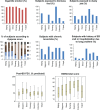Characteristics of stable chronic obstructive pulmonary disease patients in the pulmonology clinics of seven Asian cities
- PMID: 23378753
- PMCID: PMC3553655
- DOI: 10.2147/copd.s36283
Characteristics of stable chronic obstructive pulmonary disease patients in the pulmonology clinics of seven Asian cities
Abstract
Background and objectives: Chronic obstructive pulmonary disease (COPD) is responsible for significant morbidity and mortality worldwide. We evaluated the characteristics of stable COPD patients in the pulmonology clinics of seven Asian cities and also evaluated whether the exposure to biomass fuels and dusty jobs were related to respiratory symptoms, airflow limitation, and quality of life in the COPD patients.
Methods: This cross-sectional observational study recruited 922 COPD patients from seven cities of Asia. The patients underwent spirometry and were administered questionnaires about their exposure to cigarette smoking, biomass fuels, and dusty jobs in addition to respiratory symptoms and health related quality of life.
Results: Of the patients, there appeared to be variations from city to city in the history of exposure to biomass fuels and dusty jobs and also in respiratory symptoms of cough, phlegm, wheeze, and dyspnea. These symptoms were more frequent in those COPD patients with a history of exposure to biomass fuels than without and those with a history of exposure to dusty jobs than without (P < 0.01 for all comparisons). Airflow limitation was more severe in those COPD patients with a history of exposure to biomass fuels than without (52.2% predicted versus 55.9% of post-bronchodilator forced expiratory volume in 1 second [FEV(1)], P = 0.009); quality of life was poorer in those with exposure to biomass fuels than without (40.4 versus 36.2 of the St George's Respiratory Questionnaire [SGRQ] total score, P = 0.001). Airflow limitation was more severe in those COPD patients with a history of exposure to dusty jobs than without (51.2% predicted versus 57.3% of post-bronchodilator FEV(1), P < 0.001); quality of life was poorer in those with dusty jobs than without (41.0 versus 34.6 of SGRQ score, P = 0.006).
Conclusion: In Asian cities, the characteristics of COPD patients vary and the history of exposure to biomass fuels or dusty jobs was related to frequency of symptoms, severe airflow limitation, and poor quality of life.
Keywords: Asia; COPD; biomass; dust.
Figures
References
-
- Regional COPD Working Group. COPD prevalence in 12 Asia-Pacific countries and regions: projections based on the COPD prevalence estimation model. Respirology. 2003;8(2):192–198. - PubMed
-
- Tan WC, Seale P, Ip M, et al. Trends in COPD mortality and hospitalizations in countries and regions of Asia-Pacific. Respirology. 2009;14(1):90–97. - PubMed
-
- Mannino DM. COPD: epidemiology, prevalence, morbidity and mortality, and disease heterogeneity. Chest. 2002;121(Suppl 5):121S–126S. - PubMed
Publication types
MeSH terms
Substances
LinkOut - more resources
Full Text Sources
Medical


